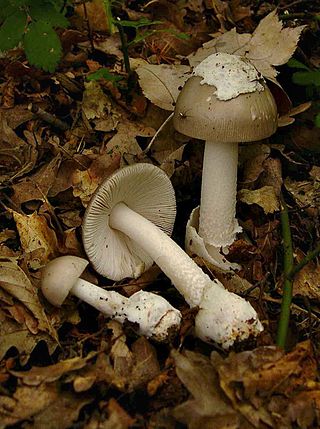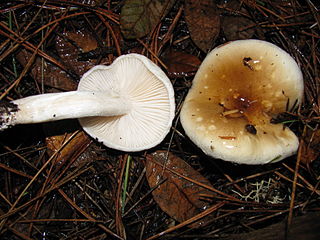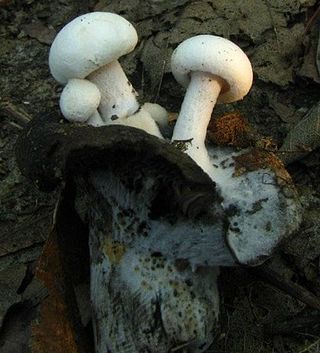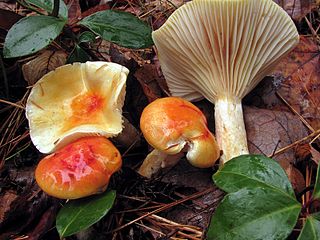
Hygrophorus is a genus of agarics in the family Hygrophoraceae. Called "woodwaxes" in the UK or "waxy caps" in North America, basidiocarps are typically fleshy, often with slimy caps and lamellae that are broadly attached to decurrent. All species are ground-dwelling and ectomycorrhizal and are typically found in woodland. Around 100 species are recognized worldwide. Fruit bodies of several species are considered edible and are sometimes offered for sale in local markets.

Clitocybe nebularis or Lepista nebularis, commonly known as the clouded agaric, cloudy clitocybe, or cloud funnel, is an abundant gilled fungus which appears both in conifer-dominated forests and broad-leaved woodland in Europe and North America. Appearing in Britain from mid to late autumn, it is edible, but may cause gastrointestinal issues.

Hygrocybe miniata, commonly known as the vermilion waxcap or miniature waxy cap, is a small, bright red or red-orange mushroom of the waxcap genus Hygrocybe. It is a cosmopolitan species, that is found worldwide. In Europe, it is found in fields, on sandy heaths, or grassy commons in the autumn. It is found in rainforest and eucalypt forest as well as heathland in Australia.

Lactarius rufus is a common, medium-sized member of the mushroom genus Lactarius, whose many members are commonly known as milkcaps. Known by the common name of the rufous milkcap, or the red hot milk cap in North America. It is dark brick red in color, and grows with pine or birch trees.

Craterellus tubaeformis is an edible fungus, also known as yellowfoot, winter mushroom, or funnel chanterelle. It is mycorrhizal, forming symbiotic associations with plants, making it very challenging to cultivate. It is smaller than the golden chanterelle and has a dark brown cap with paler gills and a hollow yellow stem. C. tubaeformis tastes stronger but less fruity than the golden chanterelle. It has a very distinctive smokey, peppery taste when raw. It grows in temperate and cold parts of Northern America and Europe, including Scandinavia, Finland, Russia, and the British Isles, as well as in the Himalayas in Asia, including Assam, in the central parts of the Indian subcontinent, and in Thailand.

Amanita vaginata, commonly known as the grisette or the grisette amanita, is an edible mushroom in the fungus family Amanitaceae. The cap is gray or brownish, 5 to 10 centimetres in diameter, and has furrows around the edge that duplicate the gill pattern underneath. Unlike many other Amanita mushrooms, A. vaginata lacks a ring on the stem.

Hygrophorus subalpinus, commonly known as the subalpine waxycap, is a species of white snowbank fungus in the family Hygrophoraceae. Found in the mountains of western North America, it is found growing on the ground under conifers, usually near snowbanks.

Hygrophorus agathosmus, commonly known as the gray almond waxy cap or the almond woodwax, is a species of fungus in the family Hygrophoraceae. It was first described by Elias Magnus Fries in 1815; Fries gave it its current name in 1838. A widespread species, it is distributed in the United States, Europe, Africa, and India, and is found growing under spruce and pine in mixed forests. The fruit bodies are characterized by a light grayish cap that measures up to 8 cm (3.1 in) in diameter, waxy gills, a dry stem, and the distinct odor of bitter almonds. An edible but bland-tasting mushroom, extracts of the fruit bodies have been shown in laboratory tests to have antimicrobial activity against various bacteria that are pathogenic to humans.

Tricholoma saponaceum, also known as the soap-scented toadstool, soapy tricholoma, soapy knight or soap tricholoma is an inedible mushroom found in woodlands in Europe and North America.

Hygrophorus bakerensis, commonly known as the Mt. Baker waxy cap, the brown almond waxy cap or the tawny almond waxy cap, is a species of fungus in the family Hygrophoraceae. It is characterized by its medium to large, relatively slender-statured fruit bodies with an almond odor, and growth often on or near rotting conifer wood. The slimy cap is brown in the center and cream to white near its curved edges. The gills and the stem are white, and in moist environments are often covered with droplets of a translucent liquid. The mushroom is known only from the United States, where it is common in coniferous forests throughout the Pacific Northwest. It was initially collected in Washington State on Mount Baker, a volcano. Although edible, the mushroom is not considered to be of high quality.

Asterophora lycoperdoides, commonly known as the star bearer, or powdery piggyback mushroom, is a species of fungus in the Lyophyllaceae family. It grows as a parasite on other mushrooms, mainly those in the genus Russula. Its gills are poorly formed or nearly absent. Asexual spores are produced on the mushrooms cap which enable the organism to clone itself easily. The spores are star-shaped, hence the name star bearer. It is regarded as nonpoisonous but inedible.

Hygrophorus marzuolus, commonly known as the March mushroom, is a species of fungus in the family Hygrophoraceae. It is known from Asia, Europe, and North America, where it grows on the ground in mixed forests at high elevations.

Hygrophorus goetzii is a species of fungus in the family Hygrophoraceae. It is a snowbank mushroom with a rosy-pink cap that fades to cream color in maturity.

Hygrophorus purpurascens, commonly known as the purple-red waxy cap, is a species of agaric fungus in the family Hygrophoraceae. Its cap has a pink background color with streaks of purplish red overlaid, and mature gills have red spots.

Hygrophorus hypothejus, commonly known as the olive-brown waxy cap, or herald of the winter, is an edible species of fungus in the genus Hygrophorus native to Europe. It appears in late autumn in coniferous forests, often with the first frosts.

Hygrophorus olivaceoalbus, commonly known as the olive wax cap or sheathed waxy cap, is a species of fungus in the genus Hygrophorus. The fruit bodies (mushrooms) appear from midsummer to late autumn under conifers in North American and Eurasian mountain forests. The mushrooms have olive-brown, slimy caps with dark streaks and a dark umbo; the caps measure 3 to 12 cm in diameter. Other characteristic features include a slimy stem up to 12 cm long that is spotted with ragged scales up to a ring-like zone. As its name implies, the mushroom has a waxy cap and gills. It is native to North America and across the northern regions of Europe. According to a publication by the Council of Europe, the fungus is nearly extinct in France.

Hygrophorus erubescens, commonly known as the blotched woodwax or pink waxcap, is an agaric fungus native to Scandinavia, Japan, Central Europe, Great Britain and North America.

Hygrophorus russula, commonly known as the pinkmottle woodwax, false russula, or russula-like waxy cap, is a fungus native to North America and Europe.

Hygrophorus pudorinus, commonly known as the blushing waxycap, turpentine waxycap, or spruce waxy cap, is a species of fungus in the genus Hygrophorus.

Hygrophorus speciosus, commonly known as the larch waxy cap, is a species of fungus in the genus Hygrophorus. While edible, the flavor of most Hygrophorus species is considered bland.




















